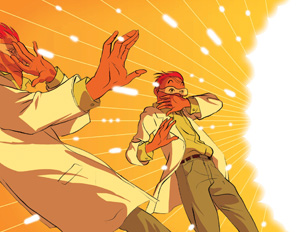Mending skin damage from an ozone hole
By RUTHANN RICHTER
Stanford dermatologic surgeon Hayes Gladstone, MD, was summoned to Chile last August on an urgent mission to help a man whose hands were being rapidly destroyed by skin cancer.
Tomer Hanuka |
|
 |
|
The 32-year-old chilean was suffering from a rare skin condition called epidermolysis bullosa, which made him particularly prone to skin tumors.
But his condition had been aggravated by a quirk of geography, for he was born in a country where the risk factors for skin cancer are extraordinarily high. Because of a hole in Chile’s ozone layer, as well as its high altitude, about one in three Chileans develop skin cancers in his or her lifetime. That compares with about one in five in the United States, says Gladstone, assistant professor of dermatology and chief of dermatologic surgery.
By the time the Chilean man had entered his 20s, he had already lost his left hand to squamous cell carcinoma, which can eat away at the bone and damage surrounding tissue. And all that remained of his right hand was a single nub of a finger, which he used to type on a computer at work, supporting himself, his mother and his sister. But now the Santiago resident stood to lose that last finger, as well as his livelihood.
A Chilean physician called in Gladstone, whom he knew from a previous medical mission in Chile. Gladstone is an expert in a high-tech, tissue-sparing technique known as Mohs micrographic surgery, commonly practiced here but unheard of in Chile. In an eight-hour operation, Gladstone was able to map microscopically the precise margins of the cancer, removing only the tumor and sparing normal tissue.
In doing so, he was able to save the remainder of the hand, much to the patient’s relief.
It was just one of many procedures Gladstone and his North American colleagues have performed in Chile to aid poverty-stricken patients who would otherwise not have access to medical care.
“A lot of the skin cancer patients would never get treated,” says Gladstone, who first led a team of eight surgeons and nurses to the South American country in 2005. “Skin cancer can eat through the bone and ultimately, if you do nothing, it can kill you. The lucky ones have a two-year wait for treatment. The unlucky ones don’t get in at all.”
Gladstone and his colleagues have donated their time and travel expenses for the work, which is sponsored by the Blade and Light Society, a group he co-founded with Murad Alam, MD, chief of cutaneous surgery at Northwestern University.
The group members now are planning a return trip to Chile in May, when they hope to treat as many as 50 patients, as well as train their Chilean colleagues in the Mohs surgery and in facial reconstruction techniques.
“These are people who are very underserved, and we are able to do something good for them. That is very satisfying,” Alam says. “We’re not only doing surgery and alleviating immediate distress, but also providing training and creating long-term ties that will help in the transmission of evolving surgical techniques.”
Gladstone says one of his goals is to raise funds for a fellowship at Stanford for a Chilean physician to undergo yearlong training in the Mohs technique and in facial reconstruction.
Comments? Contact Stanford Medicine at

